Sculpture
Newsboy- Sculpting Trick and More Research
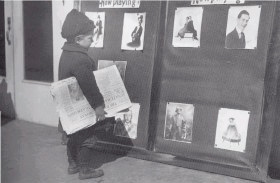
Oct 4th-11th, 2004- THIS WEEK
Sculptor Bridgette Mongeon has documented the entire process of creating a figurine of a newsboy and a life-size bronze sculpture. Watch the artist work through these posts. In this blog, she has also included information for students and teachers. In the previous post, we learned a little about The Creative Process.
If you are lost and want to go back to the chronological running list of posts, follow this link.
I wish I had more news to report this week. I am still waiting for the knickers pattern from Vintage Pattern lending Library. I do have the shirt pattern that I am working on. I have been sizing it up from the original 1920’s pattern size 8 that they had to Dusty’s size 12. I am working from the directions that I received from Amazon Dry Goods. Sizing up is not as hard as I expected. I’m basically cutting the pattern in specific areas to enlarge it. Of course the proof will be in the finished sewing. I expect to be sewing for the next few days and once done, I will frantically secure my second sitting with Dusty for those long awaited photos.
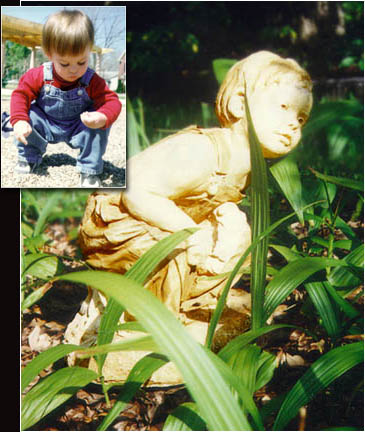
JUDGE
I have been busy this weekend once again participating in education and with young people. I have been a judge with Culture Shapers for quite a few years now. I judged the sculpture category this weekend. When first prize, for a student’s art contest, is $5,000. you want to be very sure to do your very best. Culture Shapers is a great organization and I am very proud to be associated with them.
SCULPTING TRICKS
If ever you are looking at a bronze sculpture and you think, “My this looks so realistic, the sculptor has put in every detail in the clothing”. You might want to take a closer look. You may actually be looking at real clothes. Some sculptors will sculpt an entire person and then take real clothes and put them on the figure. The clothes are dipped or coated in wax to give them some stiffness and the sculptor shapes the folds. Then a mold is made of the entire sculpture. The final sculpture is in bronze but the sculptor has not sculpted the clothes. Some artists think this is cheating.
There are even some sculptors that will take a mannequin and then put clothes on the mannequin and then make a mold and cast the sculpture in bronze. If you are wondering why some sculptures look stiff, the sculptor may have used a mannequin.
Let’s move on to the next post. The sewing pattern has arrived and the steps are revealed in Sewing A Vintage Outfit From An Old Pattern.
STUDENTS AND TEACHERS
• Have you ever been creating and felt like you have come to a wall? How did you get past it?
• What do you think about the sculpture tricks? Are they acceptable or unacceptable?
Newsboy – The Creative Process
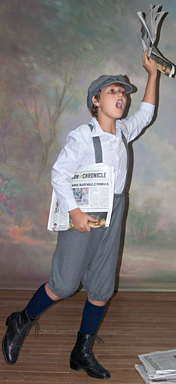
September 27th-October 3rd, 2004
Sculptor Bridgette Mongeon has documented the entire process of creating a figurine of a newsboy and a life-size bronze sculpture. Watch the artist work through these posts. In this blog, she has also included information for students and teachers. In the previous post, we watched her sew a vintage pattern for knickers.
If you are lost and want to go back to the chronological running list of posts, follow this link.
ARTICLE
This months Houston Tribune has an article about the newsboy sculpture written by yours truly. It was fun article to write, because I was able to recall my experience as a papergirl.
Happy National Newspaper week—October 3-9
International Newspaper Carrier Day—October 9th
You can read a little about National Newspaper week and Newspaper Carrier Day on the web. You might also want to learn how to fold a pressman’s hat out of newspaper.
In 1960 the International Circulation Managers Association developed a Newspaper Carriers’ hall of fame. It is now run through Newspapers Association of America. You can see a list of the inductees at this web site. I checked out the list of the inductees. It was interesting to see who was a newspaper boy or girl. The inductees that interested me were: “Red” Skelton, a comedian that I use to watch when I was a child (incidentally, he is my favorite); John Wayne, who starred in so many western movies that he has become part of the history of westerns on television (I loved watching the old westerns); and Dr. Norman Vincent Peale, I have read several of his books, and I just love them. But, these inductees are not the only newspaper carriers from history, just the ones inducted into this hall of fame.
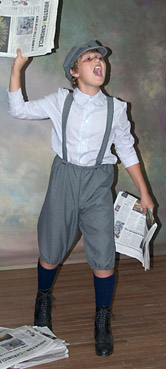
THIS WEEK’S WORK
I have not sculpted on the newsboy all week. I am still waiting for my reference photos. I did purchase material for the pattern that is coming from Vintage Pattern Lending Library (VPLL). The anticipation of getting to work on both the small sculpture and the large one is almost more than I can bear. However, I have noticed that the waiting is a part of the creative process.
Over the years, scientists have categorized the creative process into 5 sections—first insight, saturation, incubation, illumination, and implementation. There is a lot of information on this on the web. It is a fascinating subject.
As the last few weeks of these journals have shown, I have been in the saturation stage, and now I enter the incubation stage. I find incubation important for sculpting, because when I do finally get to the activity of sculpting I am energized. I am sure many will see that the actual sculpting, once begun, will go extremely fast. I will work with fervor and a great deal of passion. I am not sure how, but when everything is in place somehow that passion transfers to the clay.
While I wait, I still think about Dusty. I think about his twist, the way his legs were, how his ears stuck out over his hat, and many other nuances. I have determined the newsboy cap is not correct in the preliminary photos and I have found a pattern to make a different cap as well.
I have also spent time trying to inform teachers, students, and homeschoolers about this website. Using this web site as an educational tool has done a great deal to increase my passion for the sculpture. The newsboy represents so much more now; he represents the education and increased self-esteem of young people.
It is Friday evening and I just spoke with Janyce Engan, one of the owners at the VPLL. The patterns are on their way! Unfortunately they are in a size 8 and I need a 12. So Janyce suggested I call Amazon Dry Goods. This company has a small booklet on how to size up patterns. I think I can do it on my own but have decided to order this helpful pamphlet. Amazon Dry Goods is a wonderful resource. They also have catalogues of old patterns but more than that they have catalogues of accessories, parasols, hats, shoes etc. They also have toys and games, including paper dolls (I loved paper dolls). It is a great resource to have for period costumes.
While I had Janyce on the phone I just couldn’t help but ask her more questions about clothing throughout history. I asked her the question I posed a few weeks ago. Why did the ladies’ patterns have a waist of 26? She reminded me that a girl wore a corset from the age of 10 or 11 and continued to do so throughout their life. These bound the waist. She said she even has one pattern where the waist is 26 and the hips are 44.
Janyce said VPLL has 5,000 patterns from 1840-1949. Their customers are theater people, antique car collectors (who want to dress in the time period of their car), ballroom dancers, docents for museums, and many others.
I asked her about the boys clothing. She reminded me that for the first few years of life boys were dressed like girls. As the boys aged their length of pants was an indication of maturity. She pointed out that in the production of The Music Man, which was set in 1912, there is a song titled “You Got Trouble”, with a line that says “the minute your son leaves the house does he rebuckle his knickerbockers below the knee?” Boys wanted their knickers long to show that they were grown up, so they would buckle them below the knee.
For a little more of history…
Patterns came into existence in about 1860. James McCalls and Ebenezer Butterick began producing patterns around 1867. The sewing machine could only be afforded by the wealthy; so most garments were made by hand. I asked Janyce if the markings on the pattern would be confusing. She said VPLL scans in the patterns. They are not changed at all; however, the verbiage is upgraded to terms that someone who has knowledge of patterns would understand. For example Plait is an old form of the language for pleat.
I have toyed with the idea of sending these patterns off to a seamstress when they arrive; however, I do want to have creative input in their creation, and I think that this will most likely happen by my taking control of the sewing.
Now that we have learned about the creative process, let’s move on to the next blog that documents the process about Sculpting Tricks and More Research.
STUDENTS AND TEACHERS
• Read the article that I wrote about being a paper girl. What was I trying to save money for?
• In the history of the sewing machine, who was the first person to receive a patent on the sewing machine?
• In the 1850’s Isaac Singer built the first commercially successful sewing machine. Have you ever seen the name Singer on a sewing machine?
• Why did Elias Howe sue Isaac Singer? Did he win the lawsuit?
• Walter Hunt invented the safety pin. Do you know what else he built?
Newsboy-A Pattern For Knickers!
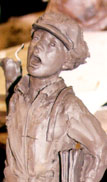
September 18-26
Sculptor Bridgette Mongeon has documented the entire process of creating a figurine of a newsboy and a life-size bronze sculpture. Watch the artist work through these posts. In this blog, she has also included information for students and teachers. In the previous post the artist talked about More Research on Clothes and the Sculpting of the Newsboy.
If you are lost and want to go back to the chronological running list of posts, follow this link.
ARTICLES
I was thrilled to receive the two articles printed by the Texas Press Association, this week. The article printed in the Messenger titled EXTRA! EXTRA! TPA revives newsboy in commemorative statue and Texas Press Association’s presidents’ column Newsboy sculpture celebrates our history.
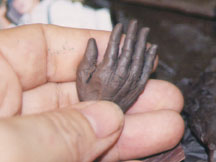
PRICES ON SCULPTURES
This newsboy sculpture will be made into a limited edition bronze in both a small tabletop size edition of 100 and a life size edition of 15. The cost of the life-size Newsboy is *$20,000. There is an additional fee of $2,000 if you desire the bronze newspaper to reflect your newspaper’s history. A small newsboy is also available making a great gift for anyone in the newspaper industry. It is a limited edition of 100. The size of the bronze is approximately 12” tall mounted on a 2” wooden base with brass plaque. The cost of the small bronze newsboy is $1,350. Contact the artist if you are interested.
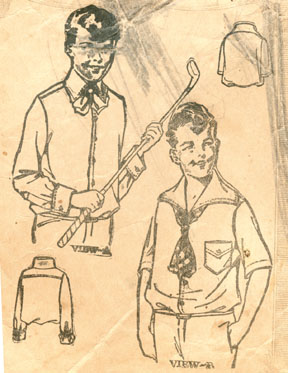
SCULPTURE PROGRESS
I have made quite a bit of progress on the small sculpture. And I am so happy with how it is coming. It is more than just how it looks, it is how it feels. The sculpture feels good and somehow that comes across to others. This element of sculpting cannot be taught. I am not even sure how to bring this element into a sculpture. It seems that sometimes it happens and sometimes it does not. I am sure it has a great deal to do with how I feel while I am sculpting and the passion for the piece. This sculpture has much going for it in both areas.
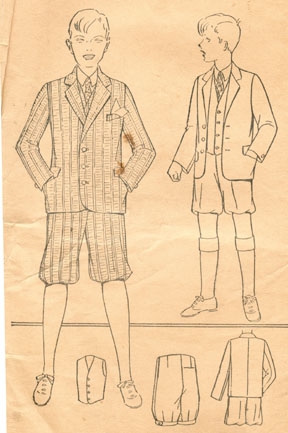
I was sad to put it away for a few days, but I am running out of things to do without my reference photos. This week I was able to finish Dusty’s face. I also cut out and sculpted some miniature newspapers.
Then I roughed in Dusty’s hands. To determine the size of a hand, I used the face that I sculpted. A hand is usually the size of the face. If you put the base of the palm of your hand against your chin, most likely your middle finger will meet your hairline. Artists use these type of measurements all the time, when sculpting, painting or drawing.
I was more than anxious to hear from Vintage Pattern Lending Library and I finally did on Thursday evening. They sent me the photos shown below. The shirt and knickers are patterns from the 1920’s. Unfortunately the patterns are in size 8, so there will be some adjusting. Vintage Pattern Lending Library can enlarge the patterns for me but I would have to wait until October 1 to receive them. My schedule with Texas Press Association would allow for this, but I cannot bear to be away from the newsboy for that long. I have requested they send me the patterns and I will see what I can do. I guess I’ll be pulling out my sewing machine next week.
Let’s move on with this project. In the next post we will learn a little bit about The Creative Process.
STUDENTS AND TEACHERS
Art
As mentioned above, artists use all sorts of measurements in their drawing, painting and sculpting. Here are a few that you can try yourself.
• Your eyes are in the middle of your head. Take a pencil and measure from your chin to your eyes, then take that measurement and compare it from your eyes to the top of your head. This is a good thing to remember when drawing a face and it is regular error that beginning drawing students make.
• This measurement shows the placement of the ear. Take a measurement from your chin to your eyes, yes the same measurement as above, but this time turn your pencil horizontally. The distance from the corner of your eye and the back of your ear should be the same as from your chin to the eye in the front. Isn’t that cool!
• A perfectly proportioned adult person is 8 1/2 heads high. Artist use the “head” measurement often. Use the illustration of the boy with the suit, the one facing you. Put your pencil lead tip at the top of his head and drop your thumb down to his chin. Now you have the size of his head. Keep moving that measurement down the boy until you find how many heads high he is. Measure yourself, your parents, your siblings how many heads high are they?
• Have you ever seen an artist with their hand out straight and one eye closed, maybe in a movie or something? They are measuring. You can do this as well. Take your pencil, as in the measuring step above, put the point of it at the top of something that you want to measure. Let’s say your doghouse in the distance. Now slowly move your thumb down to the bottom of the doghouse. What you have now is the size of your doghouse. The tip of your pencil, is the top of the dog house and your thumb is the bottom. “So, what good is that?” you ask. Well… don’t move your thumb, but take your pencil over to your own house. Just like measuring how many heads high the boy on this page is, you can measure how many doghouses will fit in the height of your own house. This measuring tool helps artist to be sure they have things in proportion. If you have already drawn the doghouse, you can now draw your own house and be pretty sure that you have it in proportion to everything else. Just like when I sculpt, it is all about comparisons, comparing the doghouse to the big house. Or, in the case of my sculpture, comparing one photo from one angle with the sculpture to another photo from another angle with the sculpture. With the measuring trick that I have just mentioned, you must not bend your elbow otherwise you will change your measurement. Keep your arm straight and look through one eye. All you need now is a canvas and paint and people will look at you and say, “My, they are a master artist!”
Newsboy-More Research and Progress on Small Newsboy
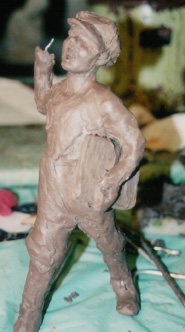
September 11th-17th, 2004
Sculptor Bridgette Mongeon has documented the entire process of creating a figurine of a newsboy and a life-size bronze sculpture. Watch the artist work through these posts. In this blog, she has also included information for students and teachers. In the previous post, we a little about the Sculpting of the Small Newsboy
If you are lost and want to go back to the chronological running list of posts, follow this link.
What an incredible week this was. Here I am, Friday afternoon, trying to type all that happened this week. The last few weeks I woke early each Saturday, because I just couldn’t wait to post the new photos and the progress on the sculpture. It’s late Friday, and I decided I better get going on the update. It is kind of hard to type on the computer while at my studio. My hands and fingers are sticky with the clay.
RESEARCH
I wish I had photos from today’s work on the newsboy, but those will have to wait until next week. I am sure you will still see some progress on the sculpture from photos taken at the beginning of the week. In all honesty, I have not been able to sculpt much on the newsboy this week. Instead, my days have been busy with changing the Texas Press section of the website to include a teacher and students’ section. Some schools are beginning to utilize this web site as an educational tool for students. I would appreciate help in getting the word out to other schools. I will continue to add a teacher and students’ section each week.
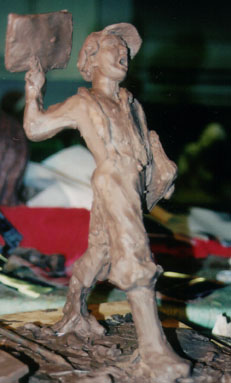
I have also been very busy doing the research on the sculpture. I put a great deal of effort into defining the final outfit and finding the suspenders. Though I would like the kind of suspenders with leather at the bottom-you know, the kind that Pa wears on Little House on the Prairie? I love that show. I did find some suspenders that will do. These are the ones with the buttons, and that was the most important thing. The way these suspenders attach to the pants, compared to the imitation button in the first photo sitting is different. Because it is different, it will make the tension on the pants different, and that changes the folds. But, I have suspenders that will work, thanks to Way We Wore Vintage Clothing. This is such a cool place to visit, and I highly recommend this vintage clothing shop to those visiting Houston. I discussed the newsboy project with Pam, the owner. She had quite a bit to share. I learned that one of the reasons why I cannot find “vintage” clothing for this project is that boys wore out their clothes. That makes sense. Girls and ladies clothing can be found, because they were so dainty in their clothing, but boys just wore out their clothes. Pam and I also talked about buttons on the boy’s 1929 clothing. She told me that looking at zippers and buttons is the way she dates clothing, and in 1929 the boys pants would have buttons. My research on the history of the zipper did prove that this is correct.

So, I was still perplexed with how these knickers should look. One of my sculpture students, a retired doctor, said he wore knickers when he was a young man. He said they ballooned much more than the one in the preliminary photo, and he agreed that they had clasps at the knees. I appreciated the first hand information.
Now, back to the Internet. What did we ever do before we had the Internet? I must have e mailed 20-30 different people, everyone from vintage clothing people, to vintage pattern people to college professors and historians. I received an e-mail from someone in the middle of the week suggesting I rent the video Newsies to see some of the outfits. I ordered it right away. Newsies is a Disney musical created a few years back. It depicts the 1899 strike of the newsboys. To my dismay, most of the older boys were wearing long pants, but a few did have knicker and almost everyone wore suspenders! I loved having the movie because it added to the passion for this piece and once again reaffirmed to me just what important things kids can do.
Thursday I received an e-mail from the Vintage Pattern Lending Library It said:
Hello Bridgett!
Sorry for the delay; we’ve been a bit busy. As it happens, we do have a book with a complete boys’ outfit, including knickers, from about 1925 which sounds like what you are looking for. Let us get back to you in a day or two with more details; we will have to draft it out of the book if you need a full-sized pattern. Hope this is helpful – your project sounds fascinating!
Best wishes,
Chaz Engan VPLL
When I received the e-mail, I screamed! Maybe my search is over. It will be something to see, this vintage pattern. Though I love to sew, I rarely do, and I would not consider myself a pro. I wonder what the pattern will look like, if it will be marked differently from patterns of today. Their site also says:
Some of the items in the VPLL archives might be the only originals in existence.
After this weeks search, I believe it. I never really thought about all of this until receiving this commission, but I am sure glad that someone has taken the initiative to preserve this part of our history. My newsboy hat is off to you VPLL!
By the way, while looking at all of these old patterns for women, I wish I could take some time to sew some for myself. I can’t help but wonder-were people smaller back then? Most of the women’s patterns are women with a size 26 waist. 26!
So, while I wait for this final outfit, I can still work on Dusty’s face on the small sculpture. That is what I have been doing for the last 24 hours. It felt good to get back to the clay, but as I feared the face grew a little bigger than the body so I made him slightly bigger than 10″. It was much easier to manipulate the roughed in body than it would be to fix an almost complete face. I wish you could see today’s photos, they will be posted next week. The sculpture has so much life to it, the turn, the step, the face, the tip of the head. In one photo, Dusty’s hat was just a bit off to the side, not much, but a bit, and I thought, OH MY, THAT IS GREAT! It was one of those happy accidents.
Even though I don’t have the last photos for reference of the figure, I can also start to prepare the large armature. As I said, this pose is great, and working it out small gives me the opportunity to see how the large armature should be constructed.
This weekend, after putting up these recent updates, I think I will pop some popcorn, watch Newsies, and maybe start a scrapbook for Dusty.
Let’s move on to the next section of this documentation. Follow along as the artist decides to make a period outfit and finds A Sewing Pattern for Knickers and Sculpting Continues.
STUDENTS AND TEACHERS
History
• There was a sales campaign for the zipper in children’s clothing in 1939. Can you search the history of the zipper link above, and tell me what items the zipper was used for before it was used on pants?
• There is a copy of the newsboy strike printed in the New York Times, July 21, 1899. Kids your age were able to change the minds of very powerful people.
“Friens and feller workers. Dis is a time which tries de hearts of men. Dis is de time when we’se got to stick together like glue…. We know wot we wants and we’ll git it even if we is blind.”
The New York Tribune quoted Kid Blink’s speech to 2,000 strikers:
Newsboy- The Sculpting
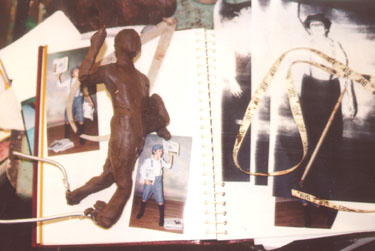
September 8-10, 2004
Sculptor Bridgette Mongeon has documented the entire process of creating a figurine of a newsboy and a life-size bronze sculpture. Watch the artist work through these posts. In this blog, she has also included information for students and teachers. In the previous post, we learned about the beginning of the sculpture.
If you are lost and want to go back to the chronological running list of posts, follow this link.

Even without the final photographs with the new outfit, there is enough reference in the first photos to put together a roughed in version of the clay on the small the sculpture. I am excited about doing this because I will be able to see the form in three dimensions.
Sometimes, during different presentations I have a friend create a 3D version of the sculpture in the computer. With a little help from a program called Poser and Photoshop, he can simulate what a sculpture might look like and we can view it from several directions. There is an example of one of this process using 3D models on this YouTube post. You will notice with the Ellie sculpture; however, that the sculpture was modified as we went along. The computer rendition is nice, but there is nothing like seeing it in clay. Then, it is my fingers that manipulate the sculpture, giving a twist here, a turn there. It’s then that the fermenting of the creativity that has been withheld for so long can come forth. There is a tremendous feeling that is associated with creativity.
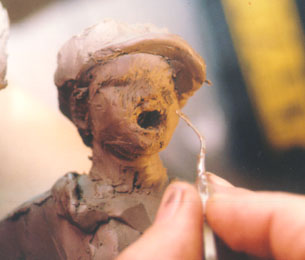
The process of putting the clay to the sculpture is taking some time. Mostly because sculpting the newsboy is my treat. I’ll work on commission A and B for a few hours, and after I do that, I will reward myself by working on the newsboy for a while.
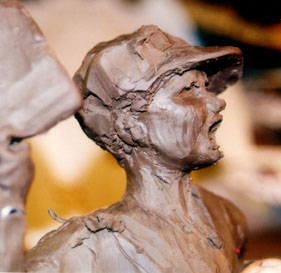
SCULPTING THE FACE
I have the general shape of the body finished, and I am very pleased. Whatever has not been worked out in the design, will work itself out as I proceed. I begin to focus on the face.Working on a one inch face of someone is no easy task. There will be a point when I will work on the face with pins and sharp knife blades, anything that will allow me to get the details that I want. My job today is to get the basic shape and to make sure it is in proportion to the body. This is essential and sometimes can prove to be a difficult undertaking. Once again, a fraction of an inch on something this size translates into something much larger when life-size. It all must look like it goes together. I force myself not to just look at the face but keep looking at the entire sculpture. I remember times when I was first sculpting when I would forget to do this and work on the head as a separate entity. I would have it perfect, and then put it with the body and find that it is off, not by much, but enough to have to start all over.
Let’s go on to the next step and learn about More Research on Clothes and Sculpting of the Newsboy.
STUDENTS AND TEACHERS
Art and Math
• On the previous page I talked about the scale of the sculpture and that the scale was two inches to one foot. The size of the finished small sculpture will be approximately ten inches. Approximately how tall is the real Dusty? If I changed the scale of the small sculpture to be three inches equals one foot how tall will the small figure be?
• What does 3D mean?
• How did the computer generated 3D figure of Ellie, in the link from above, change in comparison with the sculpted figure?
Newsboy-Beginning The Small Sculpture
Sept 5th-7th, 2004—
Sculptor Bridgette Mongeon has documented the entire process of creating a figurine of a newsboy and a life-size bronze sculpture. Watch the artist work through these posts. In this blog, she has also included information for students and teachers. In the previous post, we learned about the meeting with the Texas Press Association.
If you are lost and want to go back to the chronological running list of posts, follow this link.
I stopped by Dusty’s to get the model release form signed by his mom and to take some more measurements. I take measurements of his basic body type, ankle to knee, knee to hip etc. Then I also go ahead and take all the portrait measurements. I don’t often need all of these measurements, but it does help to have them.

SCULPTING
Today I made a wire armature for the small sculpture. I have decided to use the scale of 2 inches equals 1 foot. Basically, Dusty ends up being about 10 inches tall. In sculpting, the armature makes a big deference. They are especially important when I start doing the large piece. This armature is made with flexible wire. I utilize my measurements to help me be sure I have made it correctly. The armature should be slightly smaller so that I can add clay.
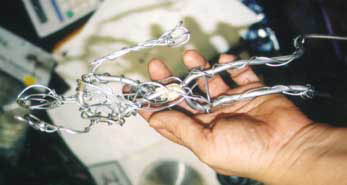
After the armature is complete I will begin adding clay to it. I have two types of clay that I work in consistently. I prefer using wet clay, however, I opt for using a wax based clay on this project. Both have their advantages—the wet clay lets me sculpt differently and adds so much to the sculpting process. The wax based clay is harder to put on and needs to be heated in a crock pot, but I do not have to keep it wet like a sculpture created in wet clay, nor is there any shrinkage. When creating a sculpture that will be around the studio for a while, wax based clay is the choice. Some day I will find the best of both clays, a wet clay that has the good characteristics of wet clay, while retaining the longevity of the wax clay.
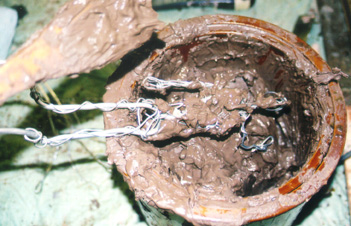
Creating the form over the armature is a lot like frosting a cake. However, you don’t want to drip this cake batter on you. It causes a nasty burn.
Today I alternate between the armature, the small Dusty, and the other commissions that are at my studio and need to be completed.

COSTUME
I am a stickler for detail. I mentioned before that I did not particularly care for the costume that we had for our first photo sitting. The bottom of the pants seems wrong. They should be buckles or buttons and not elastic. I have researched the period clothing and found this wonderful web site totally dedicated to historical boys clothing. There is an entire page about knickers. My interest, once again, was peaked when I read that little boys wore shorts and older boys wore knickers. However, when boys matured to manhood they often put away their knickers in an almost ritualistic manner as a sign of going from boyhood to manhood. I could float around on the Historical Boys Clothing website forever, but I sure wish their photos came up. I have e-mailed the webmaster for help in my research.
There is wonderful story in the page about knickers about a man who immigrated to this country from Greece in 1925. He recounts wearing knickers.
Pockets? There must be pockets. How would the boys collect their money? It would be great if I could somehow show coins in the pocket of the newsboy.
Type of material? Even though this sculpture will be bronze, the type of material does matter. If you think about it, the folds in velvet, as compared to corduroy, silk or wool, all appear to be different. A good sculptor can capture the material by the way the folds are sculpted.
Suspenders? I will have to find the correct suspenders for the project. The search is on.
Sleeves? I sure wish the sleeves had some give to them, so they could either be pushed up or rolled up, if I decided it added to the sculpture. I know all of this sounds like a lot of work to go through, but the preparation for this is important. I could begin the sculpture process without the reference, however, taking time here will make my job easier down the road. It will also add life to the piece.
I am perplexed by not being able to find the absolute correct costume. So I take a trip to Joanne’s fabric shop. I’ll make what I am looking for if I can not find it. But, to my dismay, there are not any patterns for a newsboy costume, not even knickers! Back to the Internet. The women at Joanne’s tells me that you can get all sorts of patterns from e bay on the Internet. My quick search leaves me feeling a little more restless so I decide to sleep on it. Unlike many other commissions, I am not rushed. This gives me time to do what is necessary, and in the mean time the sculpture ferments in the creative intuitive part of my brain.
An artist friend hears about my costume dilemma through e-mail and offers the terrific suggestion of contacting the costume, department of the local university. If they don’t have a costume maybe a student will help me to prepare one.
…Contacting the local university doesn’t seem to be working. They have odd hours and we keep playing telephone tag. An actor friend of mine suggests the Alley Theater, and she said she would see what she could do. I would love to have my reference photos yesterday, but I am forced to wait. So I begin to think…is the other costume that bad? It is only the knickers and the straps that are a problem. I can modify the pants legs in clay, but I must have those suspenders. Having the two button suspenders in the front will create an entirely different pattern of folds and tension. I am counting on the tension, especially in the left leg. The tension of those folds draws the eye up to the hand, the face, and the paper. It is an essential design element. I believe I can find the suspenders and use them with the original costume modifying the pockets and below the knee as necessary. But I must first exhaust all options.
Let’s move onto the next section about sculpting the small newsboy.
STUDENTS AND TEACHERS
History
• What do the Dutch settlers have to do with the pants of the Newsboy? (Hint check out the link above for knickers)
• What was the Knickerbocker Number Nine?
• What happened to the boy that immigrated to the United States. Why couldn’t he wear his knicker any longer? Has that ever happened to you?
Art
• If you had to do this research, where would you look?
Newsboy-The Meeting
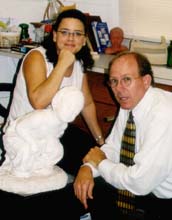
and then we sign the contract
Sculptor Bridgette Mongeon has documented the entire process of creating a figurine of a newsboy and a life-size bronze sculpture. Watch the artist work through these posts. In this blog, she has also included information for students and teachers. In the previous post, we learned how I pick a pose.
If you are lost and want to go back to the chronological running list of posts, follow this link.
Getting Ready for the Meeting
The photos are in the album, the contract is ready, and I have picked up the studio enough to be able to walk around without getting clay stuck to your shoes. I am ready for my meeting with the committee members from the Texas Press.
Visiting the Studio
Mr. Hodges and Ms. Garner Cash spent some time at the studio looking around and then we used the opportunity to shoot some photos. I explained the bronze process by showing them Ellie, a sculpture of a little girl. The first bronze was placed at the cemetery on Washington Avenue in Houston, Texas. The second one is intended for St. Mark’s United Methodist Church in Houston, Texas. After sculpting Ellie, a mold was made of her and then a wax poured in that mold. The wax is hollow and the same thickness that the bronze will be. This ‘lost wax method’ is one that we will be recording here with the sculpture of the newsboy. Oftentimes the sculpture is cut into different pieces to facilitate the foundry process.
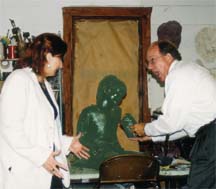
Did he Break it?
Yes, it looks like Mr. Hodges broke Ellie, but real, she is all right.
Lunch and a Review of the Pose!
After the studio, we proceeded to my favorite neighborhood restaurant, Peco’s, to discuss the schedule, the contract, and most importantly to look at the photos of Dusty. Each of us had our favorite photos and we all raised our hands at different times emulating the pose and the raising of the newspaper trying to get a feel for it. In fact we did it so often I think the waitresses, thinking that we were calling them, began to ignore us entirely.

And the Finalist is…
While everyone was eating I pulled all of the photos that were finalists together onto one page. There were about 5. After a careful look at those, it was unanimous. With a little modification to the feet of one pose, we had our newsboy!
“Meeting you, visiting your studio, seeing examples of your artistry heightened my excitement about working with you on this project. It was solid affirmation that TPA made the right choice of a sculptor for our anniversary project. Bridgette’s style perfectly captures the innocence and vitality we hope to portray with our ‘newsboy’ statue.”
Wanda Garner Cash,
President, Texas Press Association

STUDENTS AND TEACHERS
Art and History
The lost wax method of sculpting is very old. We will get to see the documentation of the lost wax method of casting with the newsboy sculpture, however you can read a little more about it under the sculpture process link at the top of this page. There is a bit of information about the history of lost wax on other web sites as well. Following this link will lead you to an animated guide to bronze casting.
Later you will see that as the work progresses, chemistry will also become a part of the artistic process.
Vocabulary
A person who works in the lost wax method and in metal is called a metallurgist.
Let’s move onto the next steps in this process- Beginning the Small Sculpture.
Newsboy-How I Pick A Pose

poses for Dusty
Sculptor Bridgette Mongeon has documented the entire process of creating a figurine of a newsboy and a life-size bronze sculpture. Watch the artist work through these posts. In this blog, she has also included information for students and teachers. In the previous post, we learned a little about the beginning of this project.
If you are lost and want to go back to the chronological running list of posts, follow this link.
I keep thinking about the boys that I have read about. Barney Flaherty, the first paperboy hired by the New York Sun in 1833. That anniversary is coming up September 4th. I never knew that until I started this project. Though Dustin is the name of the boy that I have found for the first preliminary photo shoot, I wonder who I am sculpting? Is it Little Joe, Johnny Waffles, Skinny, Mickey, or any of the other children recounted in Death of a Newsboy? I will be thinking of them all, their entrepreneurial ability, tenacity, their struggle, and their place in history.
The photo sitting was so much fun!
I was able to find a newsboy outfit at a local costume company. It is not exactly what I want. The suspenders are wrong. I’d prefer the old leather ones that button to two buttons in the front. I also don’t like that the sleeves won’t roll up. But what do I want from a costume company? This one will do for this preliminary photo shoot. After all, what I am looking for is a pose. The costume is good enough not to cause distractions when trying to pick a pose. Later I’ll modify this costume, sew my own or find authentic clothing. But I want to have this sitting done before our Thursday meeting so that those attending the meeting can help me narrow down a pose.
I was elated when I first laid eyes on the model, Dustin Lee, in his costume. Dustin is the son of a friend of mine. I have known him since he was born but have not kept up with the family. I thought he would be around 11 years of age. When the Texas Press Association contacted me and said they would like an 11-year-old boy, I drove to my friend’s home to see if his mother would be interested.
Dustin or Dusty, as I have known him all his life, was a natural. His mom, a professional photographer, had groomed him well in the concept of modeling sessions. He was also quite animated. “EXTRA, EXTRA, READ ALL ABOUT IT!” he yelled as we tried pose after pose, paper in the air, holding papers, walking, and pointing. Prior to our sitting, I explained to him the importance of a newsboy and some of the history. I thought it might help him get into his part. “Your mouth is closing too quickly” I stated, “Can you hold the A in extra like your singing? Dusty bellowed “EXTRAAAAAAAAA” as I snapped the camera. When I felt we had exhausted all possibilities, our photo session ended. The outfit went back to the costume rental, and I waited anxiously for the photos to be developed.
September 1, 2004
The photos are back, and as I am looking at them, I am searching for movement, action, something to tell a story. Though I was unsure of the pose when the feet were so far a part, I am beginning to see a hidden meaning behind it-stability, being grounded, which represents the newspaper industry in itself. I am looking at those poses differently. The ones with the twist add motion; some, where the back is arched, add a different movement. I put all the photos in a resources photo album and mark my favorites with post-its, then I hand the photo album to my an artist friend, to get his opinion.
Meanwhile, seeing Dusty, in the outfit looking at the photos and getting closer to a pose, stirs up my creativity. Now the anticipation of actually getting my hands in the clay and working on the piece is beginning to build inside me. I can even feel the little flutters in my chest as I think of it. It is a great feeling! Allowing it to ferment there is a good thing. This stage of the creative process is called saturation.
While speaking to Dusty’s mom I learn that Dusty’s grandfather is elated over the idea of the sculpture of the newsboy and Dusty’s participation. Dusty’s grandfather was a newsboy for many years. These little elements add to the personal excitement of the sculpture, to the fermenting.
Next week I sculpt. But before that, let’s look at the next post about The Meeting.
STUDENTS AND TEACHERS
Art and History
• Why did the newsboys scream, “Extra, Extra Read all About It!”
• The sculpture that I am creating is in honor of the Texas Press Association’s 125th anniversary. Can you think of some big events that happened in the last 125 years that would have been headlines in the newspapers that the newsboys carried? Here is a website that can help you- Digital History.
Newsboy Sculpture-The Beginning.
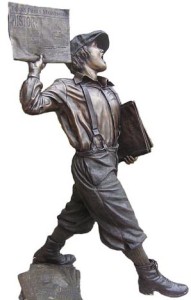
limited edition of 10. The
Newspaper that he holds
changes depending on
what headline the buyer
would like to see.
Sculptor Bridgette Mongeon has documented the entire process of creating a figurine of a newsboy and a life-size bronze sculpture. Watch the artist work through these posts. In this blog, she has also included information for students and teachers. In the previous post, we learned a little about the artists thoughts on the project.
If you are lost and want to go back to the chronological running list of posts, follow this link.
Thank you to the committee members of the Texas Press Association for choosing me as the artist for the newsboy sculpture that is intended for the state capitol. I am honored to participate in your 125th anniversary.
I was thrilled to be awarded the commission and have decided to document not only the artistic process but also the thought process of the entire work of art, an artist’s journal, so to speak. It is a way for the members of the Texas Press Association and others to witness the creative process and share in the personal thoughts of the artist.
I will try to update often, so please check back to see the progress.
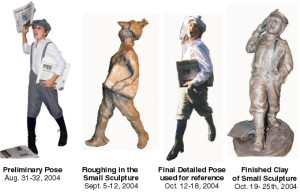
I certainly welcome and appreciate newspaper coverage, as well as any other media coverage, and I will help anyone that is interested in getting the elements that they might need to create newsworthy stories. I would also appreciate your help in spreading the news about schools that are evaluating the Texas Press section of this web site as an educational tool.
Students and teachers
At the bottom of each page, you will find information to help you learn. There will be questions, further reading and items to spark your interest. Please feel free to e-mail me with your responses and I will post what I can. Thanks for your involvement.
Bridgette Mongeon
First Paperboy, Sept. 4, 1833:
Newspaper Carrier Day on Sept. 4 marks the anniversary of the hiring of the first paperboy in the United States. In 1833, The New York Sun ran the following ad: “To the Unemployed – – A number of steady men can find employment by vending this paper. A liberal discount is allowed to those who buy to sell again.” Ten-year-old Barney Flaherty, although not a man, was the first to answer the ad.
The small newsboy sculpture is available as a limited edition bronze.
Let’s go to the next page in this chronological order of the creating of a Newsboy Sculpture- How I Pick A Pose.
Newsboy- Thoughts on The Project
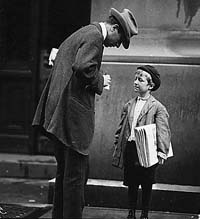
selling papers on the street.
Sculptor Bridgette Mongeon has documented the entire process of creating a figurine of a newsboy and a life-size bronze sculpture. Watch the artist work through these posts. In this blog, she has also included information for students and teachers. In the previous post, we learned a little about the history of the artist and newspapers.
If you are lost in the chronological order and want to go back to the running list of posts, follow this link.
I woke up early with newsboy on my brain. So, I thought I would do some research on them. I googled newsboy to see what came up. As I find information about newsboys I will add it to the Newsboy Links page.
Before I even begin the sculpture I can feel the passion for this piece stirring in me. These newsboys were the delivery system for news. At this time period there was no other form of delivery. I am always thrilled when I find young people who make a difference in the world. Maybe that is why I have such a desire to help youth. They can realize their potential, and, in turn, make a difference.
These young entrepreneurs made a huge difference. In the beginning, they were the only way for news to get to the public. As I google and read about things people wrote about them, I stumbled on the topic of Thomas Edison as a newsboy. He sold papers on the train as a youth. “Certainly,” I thought, “there were probably many famous people who started out as newsboys.”
I couldn’t help but imagine what it was like to be a newsboy. Yes there were newsgirls, a little unknown item of history. Newsboys needed to sell the paper, but how tempting it would be to want to keep one to read. In some cases I am sure the paper was the only source of reading material for these youth, if they could read.
THE POSE
I am waiting on a phone call from someone who has an 11 year old boy, and am hoping that he fits my image of what I think this sculpture should look like. I think I might be able to get my hands on some period clothing, though I am wondering how difficult it will be to find shoes. My plan is to set up a photo shoot to try some different ideas for the sculpture. I’m hoping, by doing this photo shoot, that I can finalize some different poses and present these photos on Thursday Sept 2, when I meet with members of the committee. Once we decide on a pose I’ll set up another photo shoot focusing on that one pose alone, taking many rolls of film. This reference will be necessary to focus on the details.
Sunday August 29, 2004
I Googled once again! This time for photos of newsboys. I came up with several different items that I will put in a reference book to refer to while sculpting. I especially love the old photos, but there is nothing new about my loving old photos, I could spend hours looking at old photos. In fact I love the research on a project just as much as I love doing the project. It is also what I love about writing.
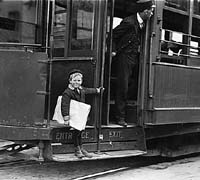
Because this sculpture is a part of history it makes it all the more fascinating for me. Though I will count on the photos from my own photo shoot, these stories and the images inspire me. If I look very closely I can look into the eyes of real children!
August 30, 2004
While pulling together the contract, I stopped at TITLE. I filled in Newsboy but I know that all sculptures tend to find their names as they progress. As I work, I will await those whispers that tell me the secret of what it should be called.
I am continuing to read the stories and history of the newsboys that I find on the Internet. I first struggled about reading Death of a Newsboy, but the massive amounts of information that was in this article written by Vincent DeGirolamo, in the Journal of Social History, is amazing. It has drawn me closer to the meaning behind the newsboys as a whole and this special boy. It will directly affect the personality of the sculpture and its spirit. Maybe this element is something that only I see or feel, or maybe it is part of what others notice and comment on when I hear them say, “Your work is so life like, or it has so much personality, or the faces, there is just something about the faces.”
I wish I had time to research some of the articles mentioned in Death of a Newsboy. I always like to saturate myself with the subject as much as possible.|
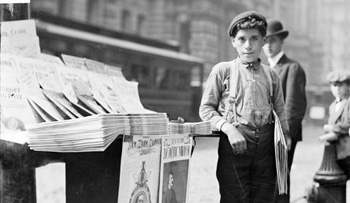
I have found a period costume for the photo shoot. Although there are some things about the outfit that I don’t like, I can change these things in the sculpture. Taking these preliminary photos will help me to define a pose. It enables me to look at alternatives that I have not seen and to notice the sculpture pose from other directions. I have found other sculptures of newsboys on the Internet. I certainly don’t want to copy them. I am waiting for this sculpture to unfold itself, though I know that ultimately the scene will come alive within the clay.
STUDENTS AND TEACHERS
Art and History
• What is the difference between a newsboy and a newscarrier?
• Do you know anyone who was a newsboy or newscarrier?
• Which character in Death of a Newsboy is your favorite and why?
• In the article, A History of Newboys in America the Spanish-American war affected the newsboys. How did it affect the newsboys in a positive way, and what affect did the end of the war have on the newsboys?
Let’s go to the next page in this chronological order of the creating of a Newsboy Sculpture and to The Beginning.
The above photos
The top two are by Hines and were found at:
http://web.mala.bc.ca/davies/H132/Hine.newsboy.street.photo.jpg
http://web.mala.bc.ca/davies/H132/Hine.newsboy.streetcar.photo.jpg
http://www.ita.doc.gov/td/oetca/cra2_files/newsboy.jpg
